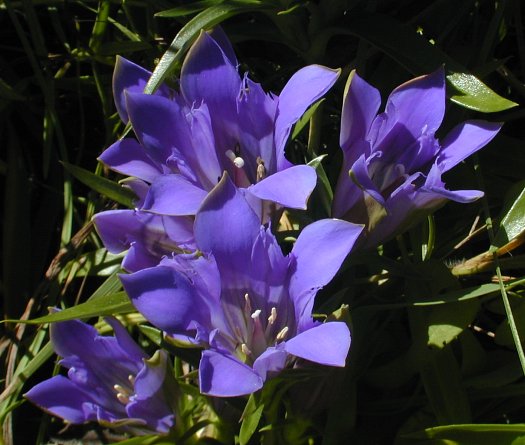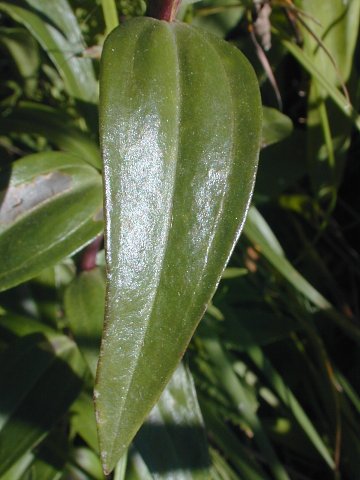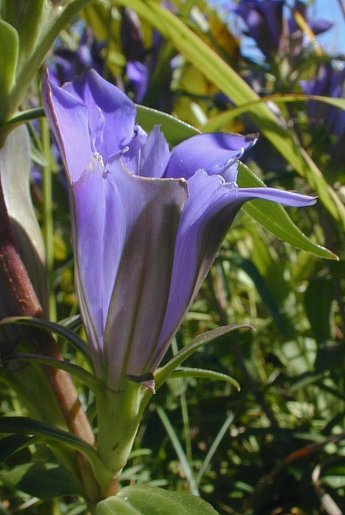Description: This perennial plant is unbranched and about ¾–1½' tall. The central stem is slightly reddish and has lines of minute white hairs that are difficult to see. The leaves are up to 3" long and 1¼" across. They are oppositely arranged along the central stem, except at the apex of the plant, where they occur in a whorl of 3-7 smaller leaves. They are lanceolate, sessile, and have smooth margins. On each leaf, there may be minute pubescence along the central vein at the base, otherwise the texture tends to be shiny. Two smaller side veins run parallel to the central vein. One or more clusters of 1-8 flowers occur at or near the apex of the plant. The inflorescence is sessile at the topmost whorl of leaves, otherwise the flowers occur on short stalks from the axils of the upper opposite leaves. The violet-blue flowers are about 2" long and 1" across when fully open. The corolla is tubular and vase-shaped, but divides into 5 small triangular lobes that reflex outward. Within the corolla, there is a prominent stigma with a divided white tip, which is surrounded by 5 stamens with white anthers. The outer sides of the corolla contain some patches of greenish violet, while it becomes whitish green near the base on the inside.

The blooming
period occurs during the fall, and lasts about a month. There is no
noticeable floral fragrance. The seed capsules split into 2 sections,
releasing numerous small seeds that can be dispersed by wind or water.
The root system consists of a long stout taproot with a few lateral
roots.
Cultivation:
The preference is full sun and average to dry soil. The soil texture
can consist of rich loam, clay-loam, or contain some gravel. Prairie
Gentian is often difficult to start from seed, but fairly easy to
establish from transplants. Foliar disease rarely bothers the leaves.
This plant is quite drought resistant.

Range &
Habitat:
The native Prairie Gentian is uncommon in NE Illinois, while it is rare
or
absent elsewhere within the state (see Distribution
Map). This is an indicator plant of original prairie and
other
high quality habitats. Such habitats include mesic to dry black soil
prairies, gravelly hill prairies, barrens with stunted trees or shrubs,
limestone glades, and prairie remnants along railroads. Occasionally,
Prairie Gentian forms small loose colonies. It adapts well to a regimen
of occasional spring wildfires, as this removes some of the grassy
debris that can smother this plant.
Faunal Associations:
Bumblebees are attracted to the nectar of the flowers and
cross-pollinate them. Some beetles may knaw on the flowers or eat the
seeds, such as Epicauta pensylvanica (Black Blister
Beetle). The seeds are too small to be of much interest to birds. Most
mammalian herbivores usually don't bother this plant because the leaves
are bitter, although White-Tailed Deer may chomp off the upper half of
its leafy stems. Overall, the value of this plant to wildlife is low.

Photographic
Location:
The photographs were taken at Loda Cemetery Prairie in Iroquois County,
Illinois.
Comments:
This is one of the most beautiful plants on the prairie during the
fall, with exceptionally vivid blue-violet flowers. Prairie Gentian can
be distinguished from other gentians that occur within the state by its
more open corolla and its small, reflexed lobes. It is also has fine
white hairs on the stems and at the base of the leaves, but they are
often hard to see. Another scientific name for this plant is Gentiana
puberula; another common name is 'Downy Gentian.'